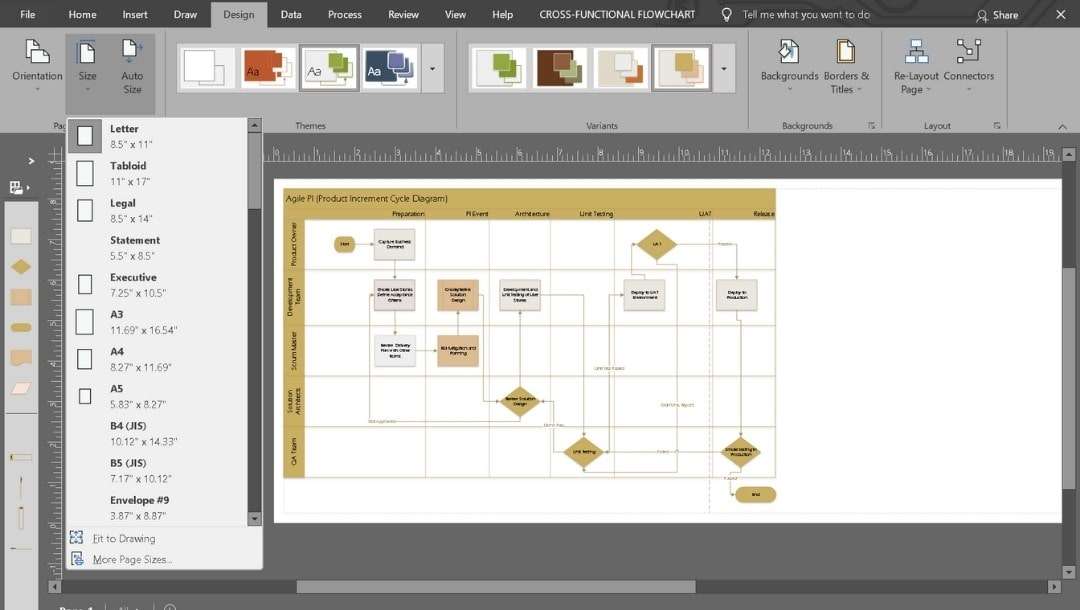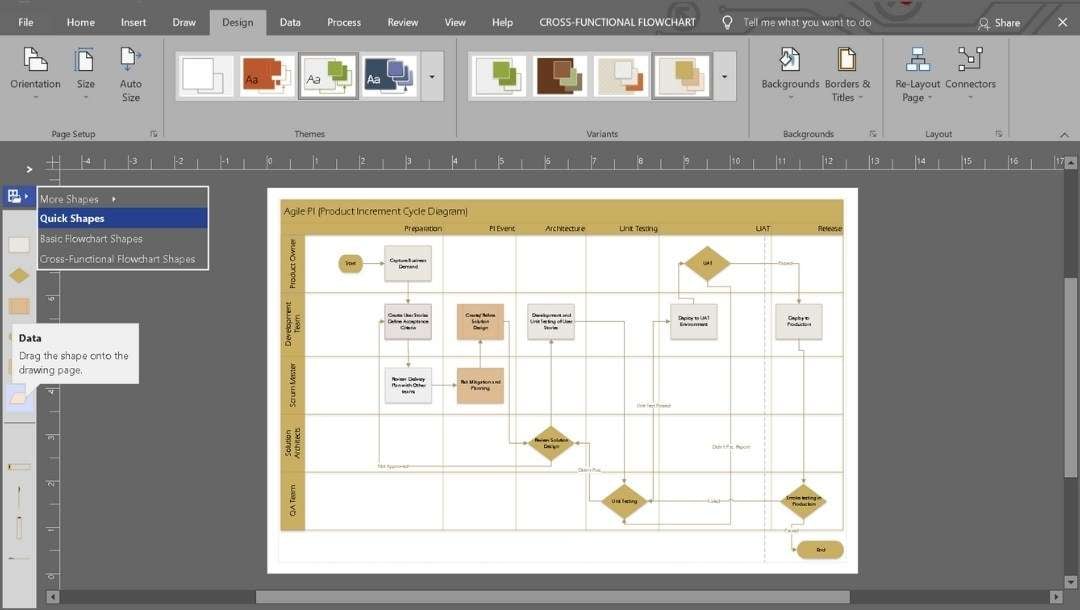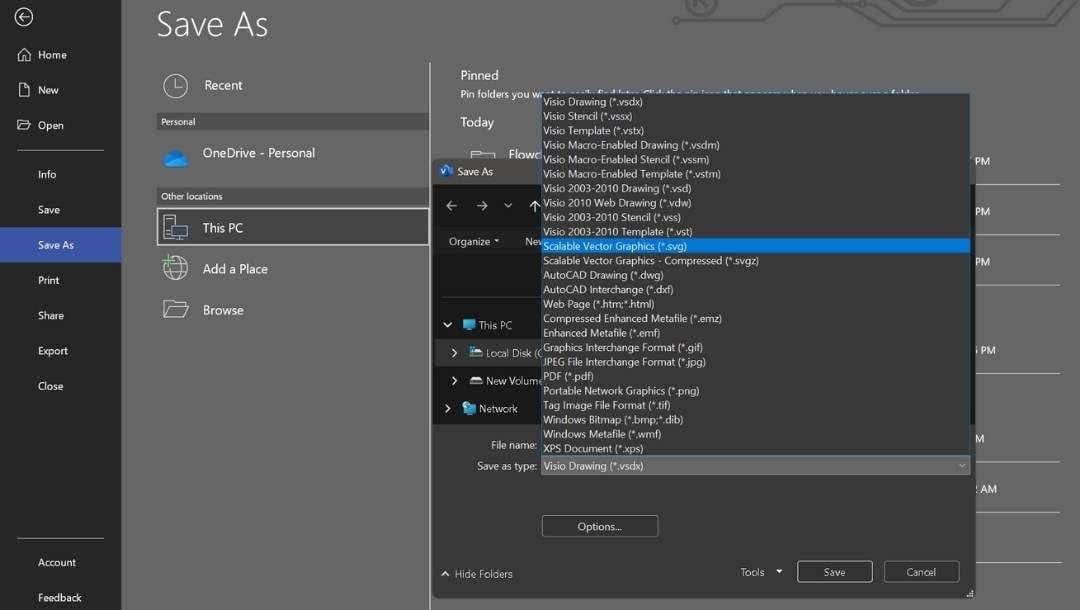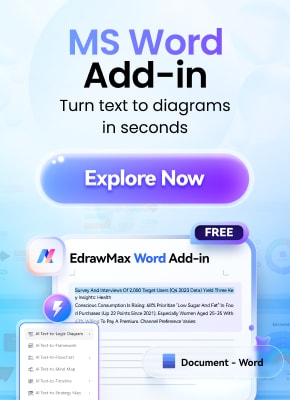Sharing Visio files is rarely smooth. If the recipient doesn’t have a compatible tool, the diagram won’t open or will get distorted.
I dealt with this when embedding diagrams into docs and online. Screenshots looked fuzzy, PDFs were too large, and editing was slow.
SVG solved these issues. It stays sharp, loads in browsers, and preserves all elements as vectors. But converting VSDX into SVG is the hurdle.
In this guide, I’ll explain step-by-step methods and how EdrawMax simplifies the VSDX to SVG conversion process.
In this article
How to Convert VSDX to SVG in Visio
To begin with, let's use Visio to do the conversion. Follow all the steps below.
Step1 Open Your VSDX File
Start Visio and select File > Open and browse through your folders.
Click the .vsdx file you intend to convert.
If it holds several pages, inspect them all. Ensure nothing is trimmed or shifted.

Step2 Prepare the Page Layout
Design tab → Size → Fit to Drawing.
Click Orientation and set it to Portrait or Landscape as required.
You can also use the select all feature (CTRL + A) and drag to center the diagram to eliminate unwanted white borders in the SVG.

Step3 Optimize the Diagram for Export
Replace unusual fonts with standard ones like Arial or Calibri. Standard fonts keep text consistent across devices.
Inspect all connectors and arrows, ensuring none are detached or loose. Remove any unnecessary shapes, hidden objects, or layers. They only increase file size.
To add new shapes, use the left side Shapes library.
Limit colors and skip complex gradients to improve browser loading speed. Before exporting, check that all shapes and labels remain sharp and readable at trim zoom levels.

Step4 Save as SVG
Go to File > Save As. Select the location on your computer or drive.
In the Save as type dropdown, choose Scalable Vector Graphics (*.svg). Change the default name if needed and press Save.

Step5 Review and Test the SVG
View the SVG in Chrome or Edge after export.
Zoom in and out to confirm lines stay sharp and free of pixels. Verify text clarity and shape alignment.
If anything fails, return to Visio, fix the diagram, and export again. Open the file in Illustrator or Inkscape for a layer and metadata check when needed professionally.
How to Convert VSDX to SVG in EdrawMax
Let's try an easier method to convert a Visio VSDX file to an SVG file.
Step1 Import the VSDX File in EdrawMax
Open EdrawMax and navigate to Import > Import Visio. Choose the VSDX diagram to convert.

Confirm all pages display shapes and text correctly.
Step2 Review and Clean Up the Diagram
Look over the imported diagram to confirm that no elements have shifted.
Adjust text or spacing where labels appear misaligned.
Simplify shadows, gradients, or effects that convert poorly to keep the SVG efficient. Resize the canvas if any parts are missing or too small.

Step3 Prepare for Export
After polishing the diagram, hit the Export icon in the top bar. Select SVG file.
In the export settings:
- Pick where to save the file.
- Use a clear name to easily identify versions.
Export every page or only the page you're viewing. Finally, press the blue Export button.
Save (CTRL+S) a .eddx version to preserve editing flexibility.

Step4 Review the Exported SVG File
View the exported file in a browser or a vector-friendly graphic tool. Zoom across sizes to check for any pixelation.
Verify color accuracy, font rendering, and line weight.
Find an error, fix it in EdrawMax, and re-export. Store the editable .eddx and the final .svg.
Why EdrawMax for VSDX to SVG Conversion
What makes EdrawMax a stronger choice isn't only the ability to export, but the tools it offers along the way.
Drag-and-Drop Import
I start by pulling the VSDX file directly into EdrawMax. The software accepts it without misaligning shapes or clipping text. Everything appears in place, ready to adjust before exporting.
Editable Elements
Once the diagram is open, I can select any object. Text blocks, arrows, and icons remain live objects rather than being flattened graphics. It allows me to resize, recolor, or adjust spacing with precision before saving the file as SVG.
Editable Layers
Each layer remains separate after import. I can lock a layer while adjusting another, or hide specific sections during cleanup. For multi-level diagrams, this control avoids confusion.
Pre-Made Templates
Sometimes, I drop the converted diagram into a template, such as a timeline or mind map. Snap lines and grids keep the flow neat, so I don't have to redraw.
Direct Export to SVG
From the top menu, I choose Export → SVG. The file saves quickly, and I can view it in a browser or graphics editor without losing clarity.
AI and Cross-Platform Benefits
The AI assistant catches uneven alignments and offers spacing suggestions. EdrawMax's cross-platform setup allows me to continue editing on a laptop, desktop, or online session with no compatibility issues.
Common Issues and Quick Fixes
Shapes or Connectors Shifting
Lines and shapes may move slightly during export. Use EdrawMax's Align and Snap-to-Grid tools to precisely reposition elements.
Fonts Changing or Resizing
Non-standard fonts often substitute automatically, causing size or spacing changes. Switch to web-safe fonts, such as Arial or Calibri, before exporting and recheck the text alignment afterwards.
Cut-Off or Misaligned Labels
Text can extend outside its shapes in SVG. Enable auto-fit for text boxes or resize shapes before exporting.
Transparency or Gradient Loss
Gradients and semi-transparent fills may look flat or inconsistent. Simplify effects to solid fills or test alternative color settings to ensure consistency across browsers.
Layer or Page Issues
Large diagrams sometimes skip pages or collapse layers. In EdrawMax, confirm "All Pages" is selected and adjust layer visibility in the Layer Panel before saving.
Extra White Margins
SVG exports can include blank borders. Resize the canvas to fit the drawing tightly to eliminate unused space.
Overlapping Shapes or Grouping Errors
Grouped objects may shift or overlap incorrectly. Ungroup, reorder using the Arrange menu, and then regroup before exporting the final version.
File Performance Problems
Heavy diagrams may slow down when opened in a browser. Break them into smaller sections, remove unused nodes, or simplify complex visuals to maintain smooth performance.
Browser Rendering Differences
SVG files may appear differently in Chrome, Edge, or Safari. Always test across at least two browsers to confirm uniform rendering.
Missing Hyperlinks or Metadata
Links and notes may disappear after export. Reapply hyperlinks directly in EdrawMax before saving and testing them in the final SVG file.
Quick Recap
SVG is great for scalability, but moving from VSDX isn't always smooth. Fonts may shift, layers can collapse, or gradients may appear off after export.
Instead of patching issues one by one, try EdrawMax, which keeps shapes, layers, and text intact. With a quick import and export, you get an SVG that's ready to use, editable, and consistent across devices.
Faqs
-
1. Can I batch convert multiple VSDX files to SVG at once?
No, Visio does not support batch export. With EdrawMax, you can import multiple files one by one, but batch automation requires scripts or third-party tools. -
2. Are SVG files from Visio editable in Illustrator or Inkscape?
Yes, but not all elements remain editable. Some connectors or text may flatten into paths. EdrawMax preserves editable objects better than Visio exports. -
3. Can I convert SVG back into VSDX?
Not directly. SVG is an output format, so importing it back into Visio won't restore all editable elements. Always keep a copy of your original VSDX or an .eddx backup from EdrawMax. -
4. Is SVG the best format if I need to print diagrams?
SVG is excellent for scalable quality, but for print, exporting to PDF is often a safer option. Some printers or publishing software don't fully support SVG. -
5. Does EdrawMax support SVG imports, or only exports?
EdrawMax allows both import and export. You can bring in existing SVGs to edit alongside VSDX files, which Visio itself doesn't handle as smoothly.




